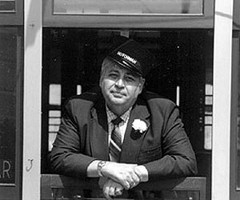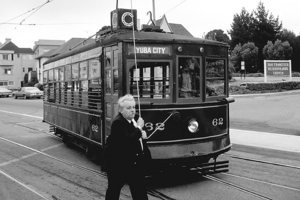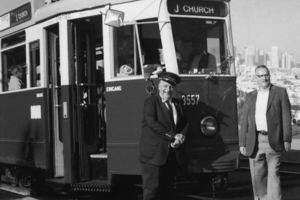 Market Street Railway photo.
Market Street Railway photo.by Rick Laubscher, Project Manager of the 1980s Trolley Festivals and Market Street Railway President
I woke up to the news on Saturday, October 1, 1988. Fellow Market Street Railway director Jack Smith was on the phone. “Rick, we lost the big man last night.” I knew immediately what he meant, though I desperately wanted to be wrong.
Maurice Klebolt was dead. The Godfather of the Trolley Festival, the saviour of streetcars on Market Street, the man who never stopped working to protect vintage rail in San Francisco…gone.
We all knew Maury was at risk. He’d had a massive heart attack three years before, and barely survived. That time, he was standing next to car No. 130 at Geneva, and was lucky enough to have been with people who administered effective CPR immediately. This time, he was sitting on his favorite bar stool at The Mint, a tavern on Market Street next to the Trolley Festival storage area where he regularly held court (Market Street Railway’s Pharr Division facility today). Though he got immediate attention this time, too, the doctors said nothing would have saved him. Maury was 58.
Maury Klebolt was an original, the kind of person you write books about. As a student of San Francisco history, I believe that, in his own way and time, Maury was as big a character as someone like Emperor Norton. He had a vision, a dream that vintage trolleys could come out of retirement–become streetcars again–and carry commuters and shoppers, not just fans, on a real transit route. He built the last ten years of his life around that dream. Everything else in his life, it seemed, was just there to fill up leftover time.

Maury Klebolt changes trolley poles on visiting Sacramento Northern streetcar No. 62, 1983, being tested (unsuccessfully) for possible use in the first Historic Trolley Festival. Market Street Railway photo.
Many people laughed at Maury, but then, those of limited perspective often laugh at those with a mission. And unlike many in the railway preservation movement, Maury wasn’t an all-talk, no-action guy. He was constantly in motion: writing letters; contributing the hard-earned profits from his small travel agency to the office holders and candidates who listened to his dreams; badgering and hectoring anybody and everybody involved in a particular decision he needed to go his way.
Bombastic? Yes. Infuriating? At times. Well-intentioned? Always. Effective? Beyond a doubt.
Maury was just like a big kid. And he knew how to use that part of his character to get away with things that no one else could have. So many memories of his exploits come to mind. Let me share just one that typified Maury’s way of doing things. He called me one day, and the conversation went something like this:
“Well, better get ready. You’ve got to go over with me to the Soviet Consulate.”
“What for?”
“To get the Russian car. What do you think?”
“What Russian car?”
“The one I used your name to line up.”
“Maury, I’ve told you you can’t…”
“It doesn’t matter, sweetness. It’s too late. I wrote the letter, told them everybody in the City wanted it in the name of world peace, that it was a great ambassador for them, and that it would get Gorbachev, or whatever their new guy’s name is, out of the chute with a big bang. It musta clanked around the Kremlin for awhile. They probably scratched their heads and said ‘Huh?’ But I just got a call from the consulate. They want it to happen, so I told them you and Barton (Carl Barton, Muni’s Trolley Festival overseer) would be over there at 11am tomorrow with me. They think you’re a real big shot.”
“Maury, I can’t go tomorrow. I’ve got a meeting in my office, and…”
“Oh, you have to go. It’ll be a diplomatic blunder if you didn’t. Big insult. Hell, you could even restart the Cold War.”
“MAURY!”
“Besides, wait till you see this car. It’s a honey. They say it was built in 1921, but you know the Commies, nothing existed before the Revolution. I think it’s really from 1912, and…”
The conversation—or Maury’s monologue—went on, and sure enough, there we were at the Soviet Consulate the next morning, talking with the commercial consul and pretending that we knew what we were doing. At one point, the deal looked like it would fall through when the consul told us we’d have to pay something like $25,000 to have the car shipped.
Maury didn’t blink.
“Oleg, what shipping line will you use?”
The consul named a Soviet shipping line.
“And who owns that shipping line?”
“Why, the Soviet people, of course.”
“And who owns the streetcar?”
“You know the answer to that. Everything in the Soviet Union is owned by the people.”
“Well, if the Soviet people are in charge, and they want to give us the streetcar, why don’t they just tell their shipping company to send it over?”
“Mr. Klebolt, it’s not that simple…”
“Huh? I thought you had the worker’s paradise over there. Don’t tell me your bureaucracy is as bad as ours. It sounds like your place is one big Muni. Can’t do anything without talking it to death. Gotta get this going, so it can be here for the big celebration.”
“Celebration?”
“Why, sure. We’ve got the Mayor all lined up to drive the car up Market Street, with throngs watching, cheering the friendship of the Soviet and American peoples, big presentation, a plaque on the car, television cameras for days. You’ll be on the networks. Moscow will probably make you a hero or put you in the Kremlin wall or something.”
“Welllll… what if I can get it shipped as far as Los Angeles?”

Maurice Klebolt poses with his pride and joy, Hamburg tram No. 3557, along with then-Muni General Manager Harold Geissenheimer, at 20th & Church Streets during the Trolley Festival of 1984. Market Street Railway photo.
I can’t guarantee you every quote in that story is right on the money, but it’s close, and I know it captures the spirit of Maury Klebolt. And if you change the players and the circumstances, it’s pretty much the story of the Hamburg car, the two Milan cars, and the two Japanese cars, and the Seattle trolley coaches, and so much else about the Trolley Festival, and the future F-line, that we all value.
To Maury Klebolt, “no!” meant “Yes, but don’t let me catch you;” “maybe” meant “Tell them to ship it tomorrow and sign my name to the bill;” and “yes” meant “Get three, they’re small.”
In a world of Xerox copies, Maury was one of a kind. We can never replace him. We can only dedicate ourselves to do all we can, in our own tepid styles, to make sure his remaining dreams come true. For without Maurice Klebolt, there’d be no rails in the new pavement they’re putting on Market Street today; no Trolley Festival; no summer Embarcadero experiments; no Wharf extension; none of it. Anybody who believes differently is just fooling himself.
It was fitting that he was scheming and dreaming right up to the end. Maury had supported Sup. Jack Molinari to replace Dianne Feinstein as mayor. Jack and Dianne have both been big Trolley Festival supporters, but Jack lost to Art Agnos, a state legislator of Greek heritage who knew almost nothing about the Trolley Festival, and would have every right to be suspicious of a project so close to the heart of his opponent. If this turn of events fazed Maury, he didn’t show it.
The day after I learned of Maury’s death, I shared it with a high City official close to the new mayor. He was genuinely saddened, for though he said he thought Maury was a real thorn in his side sometimes (not his exact phrase), he knew Maury always wanted to do things that made The City better. Then he paused for a minute, looked at me, and said, “Say, you don’t know anything about this Athens trolley Maury was working on, do you? He said we could have a big Greek party to welcome it, and the mayor could drive it, and…”
If St. Peter’s thinking about dieselizing the streetcar routes of Heaven, he’d better think again. Clear track ahead, Maury. Put it to the brass. We miss you already. We’ll never see your like again.
______________________
Editor’s Note: Read this classic Chronicle article on one of Maury Klebolt’s most famous exploits.